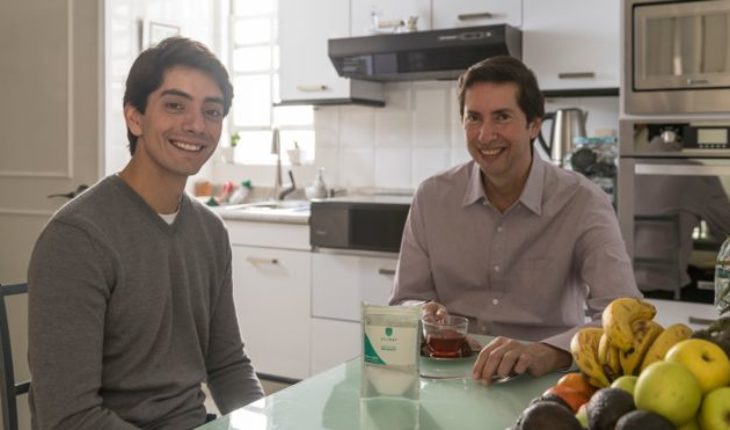The Mexican Javier Larragoiti tried to help his father He stopped skipping his diet and ended up creating a business.
At 28 years, he is the founder of Xilinat, a company that developed a sweetener very similar to sugar that is made from agricultural waste.
His invention earned him in 2017 to be included in the list of leading innovators under the 35 years of the Massachusetts Institute of Technology (MIT).
The story of how he got there begins in 2009, when his father, at 49 years, is diagnosed with type 2 diabetes and has trouble accepting that medical sentence that accompanies this painful and even impossible to meet: no more sugar.
Especially in Mexico, where 85% of the population consumes it above what the World Health Organization (WHO) recommends.
“He never succeeded,” laughs Larragoiti.
“Never stopped consuming sugar and that was just what motivated me to generate an option that was healthy and attractive, because the flavor of the substitutes that are already in the market as sucralose or stevia not end up convincing people” , he tells BBC World on the phone.
Xilinat is a sweetener made with corn residues. Coming from a “chocolate” family, Larragoiti thought of using the studies that was about to begin, chemical engineering, to find an alternative to sugar that differs from the rest in the taste, but also in the price.
First, he tried to create a pill that made the food taste sweeter. “I was like two years working on that idea. In the end it went out to the Japanese market and used there. ”
But, he says he had the “luck” of not being “in love” with the solution but of the problem of giving an alternative to the 8.7 million of Mexicans diagnosed with diabetes who have turned the country into the ninth where this evil suffers most.
So he began to look for other ways to sweeten his father’s life without his health being harmed.
With the help of her sister
The sister of Javier Larragoiti, Yonuen, studied to be a dentist and dedicated his thesis to study the xylitol, which is obtained from Birch.
Among the properties attributed to him, is to protect teeth against decay, so the young woman wanted to argue what benefits she could have for children.
But xylitol is, above all, a natural sweetener, so the student soon recommend his brother.
“We tried it and saw that it had exactly the same taste as sugar. Besides, it looked practically the same, “recalls the founder of Xilinat.
85% of Mexicans consume more sugar than that recommended by WHO. ” Then researching a little why despite having these beneficial properties had not become popular at the global level; We discovered it was very expensive. The current xylitol production is quite expensive and that’s how we started working on generating a much cheaper option to make xylitol accessible to all. ”
The young man consulted some professors and decided to replace the birch with a cheaper compound: organic waste.
Looking for the perfect residue
To achieve these, resorted to the Central de Abasto in Mexico City, the largest wholesale and retail market in the capital: “We used a mixture of waste from everything that gave us: flowers, fruit that had been left or the leaves that they removed from some products To be able to clean them. ”
But this method had its drawbacks, as he and his collaborators had to make up for what was there.
“For example, I remember that in February and March we had much residue of citrus peel because in that same market they make juices. Then we would take the orange peel, tangerine, grapefruit… It is very rich in a thing called pectin, which in fact is useful for making jams. Then at the time of fermentation, Pectin was released and we stayed with a superviscous broth that later cost us a lot of work to purify. ”
Xilinat manufactures its product in a handcrafted way in a laboratory. But it expects to industrialize in the next two years. But the guild realized that they were using their garbage as raw material so they started to charge more for it. This was added to the insecurity of the area: “The last two times we went took the cell phone. So we decided not to participate there anymore. ”
They changed the merchants for peasants and that’s how they came to the perfect residue: the “olote”, as the Mexicans call what is left of the corn once all the grains have been removed.
“We decided to migrate to a product that was much more homogeneous and abundant throughout the country, because being tortilla lovers, maize is our number one product,” he says.
“We buy it from peasants who are in a state of poverty, who are the majority, unfortunately. So we also avoid burning them, which is what commonly happens throughout the Americas: from Latin America to Canada and the U.S., peasants usually incinerate their waste to reduce them to ashes to make it easier to clean. But this practice generates heaps of contaminants. ”
Industrialization
The result of the efforts of Larragoiti and a team formed by his fellow university, Isabela Fernandez, and two of his professors, Lorena Pedraza and Héctor Toribio; It is a xylitol that costs US $2.4 a kilo, compared to US $6 to be paid for the birch; As the young entrepreneur explains.
“The idea is to lower it to US $1 a kilo so that its price is closer to the sugar.”
Mexico is the ninth country with the most cases of diabetes. To achieve this, he hopes to industrialize the production of Xilinat in the next two years with the more than $300,000 of the prize the Venture that gave this year the brand of whisky Chivas Regal.
Today, Xilinat employs a dozen people, who produce the product in a handcrafted way.
Just half a year ago they started to market it on their website, their only sales channel. They have received some orders from Colombia and the south of the United States, but as their production capacity in the laboratory is small, they prefer to concentrate on the Mexican market for the moment.
And what does your first customer think?
“My father always says he is very proud and he uses the product every day, and the best change is that, as this already tastes like sugar, he no longer feels the need to cheat in the diet.”
He puts it in the coffee, the tea and sprinkles it on the fruits he eats every morning.
Although twice a week, the “luxury” is allowed to eat two postrecitos with sugar.
translated from Spanish: Javier Larragoiti, the Mexican who developed an alternative to sugar for his diabetic father and ended up creating a business
May 30, 2019 |





